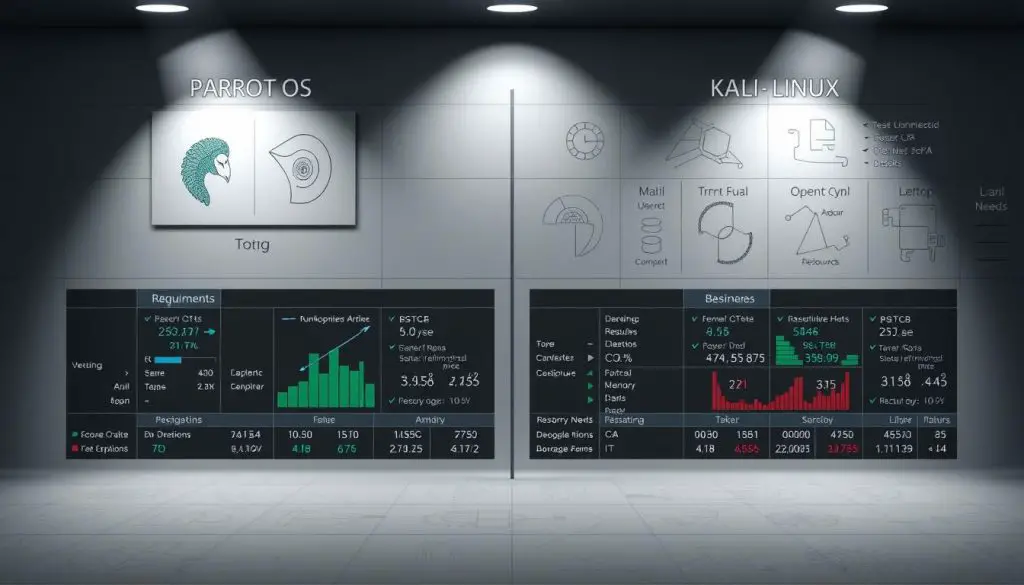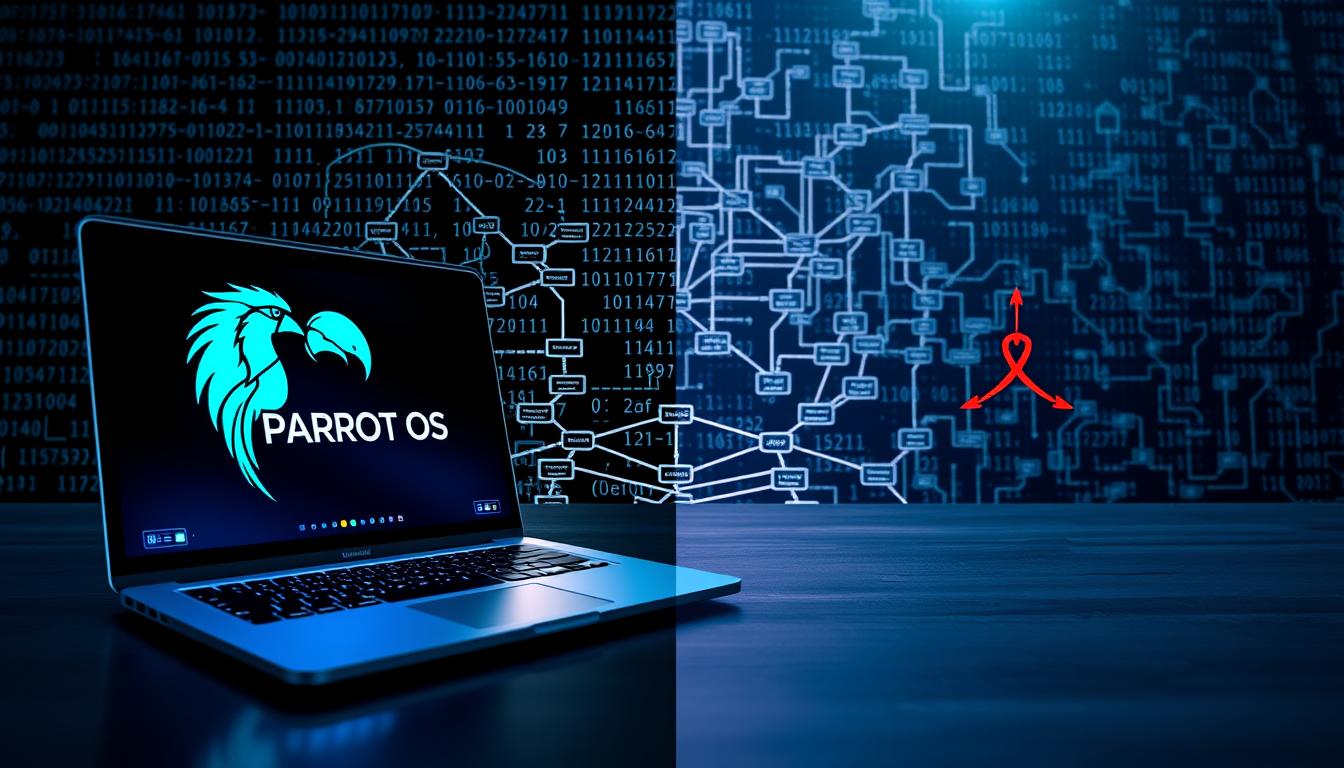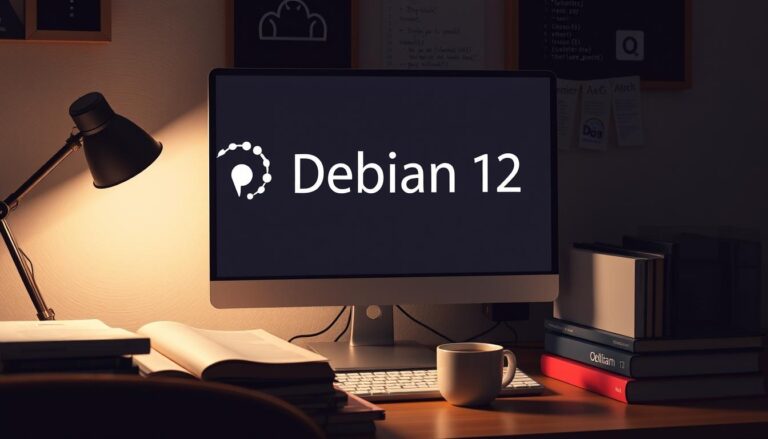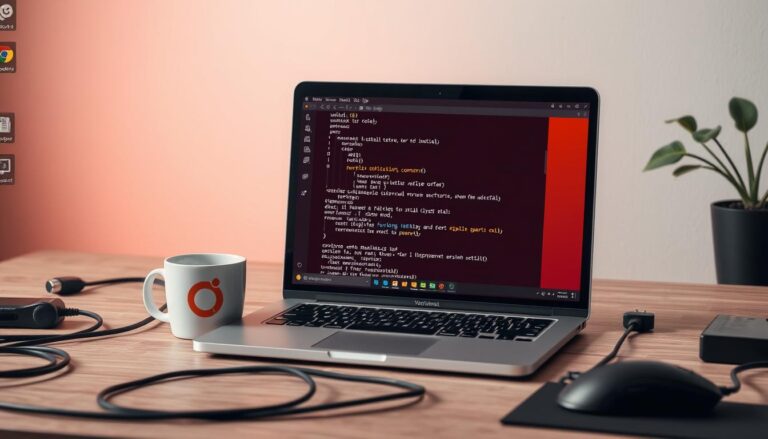Parrot OS vs Kali: A Detailed Comparison Guide
What if the most popular operating system for cybersecurity isn’t necessarily the best one for your specific needs? The world of penetration testing demands powerful tools, but the right foundation is critical for success. We introduce two leading platforms that emerged in 2013, each with a distinct philosophy. One is Kali Linux, developed by OffSec with a heritage tracing back to BackTrack. It is widely recognized as the industry standard for ethical hacking. The other is a community-driven alternative built with a focus on performance and privacy. This guide cuts through the noise to help you make an informed choice. We will explore their core differences in performance, toolset, and ideal user scenarios.
Understanding these distinctions is vital for any security professional or enthusiast. The right selection can dramatically impact your workflow efficiency during penetration testing engagements.
Key Takeaways
- Both distributions are Debian-based and designed specifically for security tasks.
- They were both released in 2013 but have different development backgrounds.
- Each platform comes pre-loaded with a massive arsenal of over 600 tools.
- The choice often comes down to system resource requirements and user experience.
- Understanding the core philosophy behind each operating system is key to selecting the right one.
- This guide provides a detailed breakdown to simplify your decision-making process.
Introduction and Overview
Selecting the optimal foundation for security assessments involves evaluating multiple technical and practical factors. Both platforms serve the cybersecurity community with specialized tools and capabilities.
Purpose of the Comparison
We designed this analysis to help professionals make informed decisions about their primary penetration testing environment. The choice between these distributions significantly impacts workflow efficiency.
Our comparison addresses diverse user needs. It serves both experienced security experts and newcomers to information security practices.
Key Areas of Focus
We examine critical aspects that differentiate these operating system options. Our analysis covers system architecture and pre-installed tools.
Hardware requirements and user interface design receive detailed attention. We also evaluate community support and real-world penetration testing applications.
Performance metrics and resource consumption patterns are essential considerations. These factors directly affect professionals conducting security assessments.
While both distributions share similar cybersecurity purposes, their philosophical approaches create meaningful distinctions. This comparison goes beyond feature lists to examine practical implementation.
History and Development of Kali Linux
When OffSec transformed the BackTrack framework into Kali Linux in 2013, they established a new benchmark for penetration testing platforms. This transition addressed significant reliability issues that had plagued the earlier distribution.
Milestones and Evolution from BackTrack
The evolution from BackTrack represented a fundamental shift in approach. OffSec brought professional development practices to what was previously a community-driven project.
This corporate backing established immediate credibility through association with industry certifications. These include the prestigious OSCP and OSEP credentials.
Notable Updates and Improvements
Recent Kali Linux updates have focused heavily on stability and security. The transition from root-default user access to sudo privilege escalation was a major milestone.
The adoption of a rolling release model ensures continuous updates to security tools. This keeps the distribution current against evolving threats.
We’ve also seen the recent switch from Bash to Zsh as the default shell. This change provides advanced features that streamline command-line workflows for security professionals.
These consistent improvements demonstrate Kali’s commitment to maintaining its position as the gold standard for penetration testing.
History and Community-Driven Development of Parrot OS
Unlike corporate-backed alternatives, Parrot Security OS built its foundation on passionate community collaboration. This distribution emerged in 2013 with a clear mission to honor BackTrack’s legacy while addressing its limitations.
Foundational Beginnings and Early Releases
The platform began as FrozenBox before evolving into the Parrot Security we know today. Under Lorenzo Faletra’s leadership since 2017, the independent development team has maintained consistent direction.
This Linux distribution focuses on both penetration testing capabilities and broader digital protection. The philosophy extends beyond offensive security to include privacy and anonymity features.
Continuous Community Contributions
The community-driven model enables rapid innovation through global enthusiast participation. Security experts voluntarily contribute to testing, documentation, and tool integration.
Despite a smaller team compared to corporate distributions, Parrot Security delivers frequent updates. The development approach includes rigorous stability testing through moderated repositories.
This ensures compatibility verification before updates reach users. The platform’s reliability stems from this careful community management process. As highlighted in a comprehensive comparison, this unique development approach sets Parrot apart.
parrot os vs kali: Key Features and Differences
Beyond surface-level similarities, these distributions diverge significantly in their technical implementations and default configurations. We examine how these choices impact practical workflows for security professionals.
Pre-Installed Tools and Specializations
Both platforms come pre-installed with extensive security tool collections exceeding 600 applications. However, their specialization approaches differ substantially.
The penetration-focused distribution prioritizes testing utilities exclusively. It deliberately excludes general productivity software to maintain a pure security environment.
In contrast, the community-driven alternative includes broader privacy and encryption tools. It also provides basic office applications, supporting potential daily-use scenarios beyond security tasks.
Custom Kernel and Desktop Environment Variations
Architectural differences extend to core system components. One platform features a custom-hardened kernel designed for maximum intrusion resistance.
Desktop environment choices reflect distinct performance philosophies. XfCE serves as the standard interface for the penetration testing specialist, optimized for efficiency.
Meanwhile, MATE provides the default desktop for the privacy-focused distribution. These environment selections align with each platform’s performance characteristics and target user preferences.
Shell configurations further demonstrate philosophical differences. Zsh offers advanced features for power users, while Bash maintains compatibility for those preferring traditional workflows.
User Experience and Interface Comparison
For newcomers to cybersecurity, the initial interface interaction often determines long-term adoption success. We examine how these platforms balance power with approachability.
Desktop Environments and Command Line Options
The desktop environment significantly impacts workflow efficiency. One platform uses XfCE for lightweight performance and extensive customization capabilities.
Meanwhile, the alternative employs MATE with a cleaner, more intuitive design. This environment prioritizes simplicity while maintaining responsive performance.
Command-line experiences differ notably between distributions. Kali Linux leverages Zsh with advanced autocomplete features. The other system retains Bash for universal familiarity.
Accessibility and Ease of Use for Beginners
Beginners often find one interface more welcoming due to its organized menu system. Tools are logically categorized, reducing initial overwhelm.
The other platform’s user interface feels familiar to Debian users but presents a steeper learning curve. Both systems handle the challenge of 600+ tools effectively.
For those starting their security journey, one distribution may offer advantages through responsive performance on modest hardware. This reduces technical barriers for beginners developing penetration testing skills.
Both platforms provide robust graphical interfaces alongside powerful terminal tools. Security professionals frequently alternate between GUI applications and command-line tools during assessments.
When considering container management solutions, the choice of distribution can influence integration workflows and tool accessibility.
System Requirements and Performance Analysis
Hardware compatibility and resource efficiency play crucial roles in determining which security distribution best suits your operational needs. We examine how these platforms perform under different hardware constraints.
Hardware Specifications
The system requirements reveal significant differences in resource optimization. Kali Linux demands 1GB RAM minimum with 20GB storage space, while Parrot Security operates efficiently with just 512MB RAM and 15GB storage.
Processor requirements show both platforms function on 1GHz processors. However, one requires dual-core as minimum while the other recommends it. This reflects different architectural approaches.

Performance Benchmarks on Modest Hardware
Performance testing demonstrates notable responsiveness differences. The lightweight distribution consistently delivers snappy operation on dated hardware configurations.
Storage space considerations become critical for users with limited capacity. The smaller footprint provides flexibility when installing from USB or running multiple virtual machines.
Neither operating system requires dedicated graphical acceleration. This makes both suitable for deployment on various system types without discrete GPUs.
The performance advantages become particularly valuable during security assessments. Professionals often need to boot live systems on unfamiliar hardware with unknown specifications.
Toolset and Functionality Review
The arsenal of security tools available in each distribution represents their core operational capabilities. We examine how these extensive collections support different security workflows and specializations.
Penetration Testing and Forensic Tools
Both platforms come pre-loaded with over 600 applications for security assessments. The tool organization follows logical categories that streamline workflow during penetration testing engagements.
While there’s substantial overlap in core penetration testing utilities, each system offers unique advantages. One distribution excels with privacy-focused applications like AnonSurf for system-wide anonymity.
Wireless network testing receives special attention with exclusive tools for security professionals. These capabilities enhance comprehensive security assessments beyond standard penetration testing toolkits.
The forensic capabilities extend to incident response and digital investigation tools. Both systems provide memory analysis frameworks and evidence collection applications essential for thorough security testing.
When setting up your testing environment, consider how tool accessibility impacts your security workflow efficiency. The right toolset organization can significantly accelerate penetration testing processes.
Community Support, Documentation, and Updates
Behind every powerful security platform lies a critical infrastructure of community support and documentation resources. These elements often determine how effectively users can leverage the distribution’s capabilities in real-world scenarios.
Support Channels and Official Documentation
We find significant differences in support ecosystems between these platforms. Kali Linux benefits from a massive, enthusiastic user base built over years of industry recognition.
The corporate-backed distribution provides extensive forums and active discussion channels. This creates rapid community responses to technical questions during security assessments.
Parrot Security’s community-driven model creates a loyal, engaged following. While smaller in scale, this community often provides more personalized support for unique issues.
Documentation quality reveals another important distinction. Kali’s OffSec-maintained materials offer exceptional depth and comprehensiveness.
These resources cover everything from basic installation to advanced development topics. Parrot Security’s documentation, while less extensive, covers essential topics adequately.
Update management philosophies differ significantly between the distributions. Kali follows a rolling release model that delivers cutting-edge tools continuously.
This approach can introduce potential stability challenges due to update frequency. Parrot Security uses a moderated update schedule that prioritizes system reliability.
Both platforms utilize Debian’s proven APT package management system. This provides familiar, reliable mechanisms for software installation and dependency resolution.
The support infrastructure differences reflect each distribution’s organizational model. Corporate resources enable professional documentation teams for one platform.
The community-driven alternative relies on volunteer contributions for its support ecosystem. Both approaches effectively serve their respective user communities.
Use Cases and Suitability for Different Users
Choosing the right security platform depends heavily on the user’s specific objectives and technical background. We examine how these distributions serve distinct audiences with varying requirements.
Professional, Beginner, and Daily Use Scenarios
For security professionals pursuing certifications, one platform stands as the industry standard. Many certification exams specifically require familiarity with its toolset and environment.
Penetration testers conducting client assessments benefit from its cutting-edge updates. The extensive community resources support complex security tasks effectively.
Beginners entering ethical hacking face an important choice. One distribution offers gentler learning curves through superior stability and intuitive interfaces.
However, the other platform’s prevalence in training materials helps students follow tutorials more easily. This consideration is vital for those new to security systems.
Daily use scenarios reveal significant differences between the platforms. One explicitly discourages general-purpose computing due to potential instability from security tools.
The alternative supports broader computing needs with pre-installed applications. This makes it suitable for resource-constrained environments and educational settings.
Both platforms work well as virtual machines or bootable drives. This allows security professionals to maintain clean testing environments separate from primary work systems.
Conclusion
Our comprehensive analysis reveals that the decision between these two powerful distributions hinges on specific operational requirements. Each platform demonstrates distinct advantages that cater to different security workflows and user preferences.
Kali Linux stands as the industry benchmark for professional penetration testing engagements. Its corporate backing and certification alignment make it essential for career advancement. The platform offers cutting-edge tools but demands substantial system resources.
Parrot Security excels where efficiency and stability take priority. Its lightweight architecture performs exceptionally on modest hardware while maintaining reliability. The intuitive interface and broader toolset support diverse security scenarios beyond pure penetration testing.
We recommend evaluating your hardware constraints, professional goals, and specific testing needs before making your final choice. Both distributions deliver robust capabilities for modern cybersecurity challenges.
FAQ
Which operating system is better for a beginner in ethical hacking?
Does Kali Linux offer better penetration testing tools than Parrot OS?
How do the system requirements compare for running these operating systems?
Which distribution receives more frequent security updates?
Can I use either system for purposes other than security testing?
What are the main differences in the default desktop environments?
- About the Author
- Latest Posts
Claudia Rothenhorst ist Medien- und Reise-Redakteurin bei der Web-Redaktion. In ihrer Freizeit reist sie gerne und schreibt darüber unter anderem auf Reisemagazin.biz.
Weitere Artikel von Ihr erscheinen u.a. im Blog der Webagentur Awantego.






